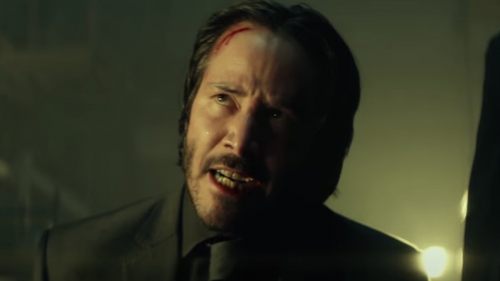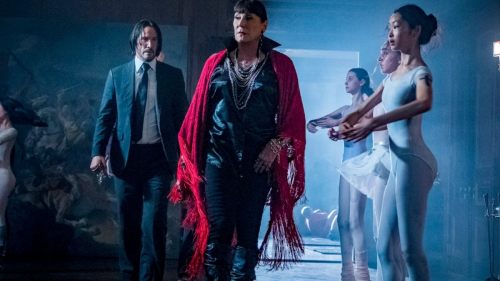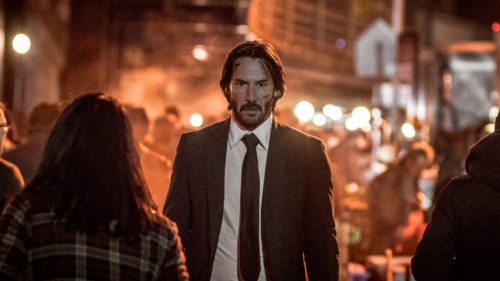JOHN WICK: CHAPTER 2 Review: He’s Back And No Skull Is Safe
The original John Wick is the rarest of cinematic treats: a genuine, contemporary cult object that you either get or you don’t. It’s based on nothing more than writer Derek Kolstad’s ample imagination. There’s no comic book to pillage from, no obscure foreign language classic to mangle, and no anime to white-wash, but all of those influences are there — explicit homages, proud winks, and more. But like the cult genre classics of my youth — Big Trouble in Little China, The Adventures of Buckaroo Banzai Across the Eight Dimension, etc. — there was a layer of mythology to dig down to if you cared to make the effort.
Unlike those '80s curiosities, John Wick actually got a sequel. John Wick: Chapter 2 elaborates on the sparse, shadowy details regarding the Continental, the society of assassins, and every other bit of garnish on the filmic steak of the original. Most importantly, it does so without robbing the first movie of its intrigue.
Chapter 2 picks up where its predecessor left off, with John out to rescue his car from the Russian mob. The vehicular stunts pulled off by director Chad Stahelski might be the most memorable set piece in the entire picture, with an underground tunnel fight in Italy taking the silver medal. One of the things I love about an action movie is when it sets the bar as high as possible in the first 15 minutes.
As a James Bond aficionado, I have fond memories of the level of unchecked spectacle that kicks off The Spy Who Loved Me, GoldenEye, and The Living Daylights. This is especially important in Chapter 2 because, as one might expect from a second installment in a budding franchise, the protagonist is going to be put through more than his or her share of turmoil.
The plot mechanics required to get John Wick shooting people in the head after explicitly retiring in the last film might irk some, but in a series predicated on relishing the joy in abject absurdity, only the most fickle among us will find fault. Wick is pressed back into service by the Italian gangster Santino D’Antonio (Riccardo Scamarcio, in full-on Eurotrash villain mode). Santino helped John retire off-screen before the events of the last movie, which means he is owed a life debt, represented by a gold medallion that opens to reveal a piece of paper with two bloody thumbprints on it. That debt can only be repaid if Wick murders Santino’s sister, so that he can take her place at the enigmatic High Table.
Rules hold the John Wick universe together, both in the sense of the machinations of Ian McShane’s lordly Winston, and the Continental organization he runs, but also in the mechanics of the story. The blood oaths and florid customs of the assassin could seem arbitrary, or merely a plot contrivance — a way to get Character A to Point B so he can Shoot Character C with a machine gun.
In Chapter 2, the rules are laid out and adhered to. A magnificent early fight between Wick and his opposite number, Cassian (portrayed by a game Common), hinges on how seriously these killers take the decorum and etiquette of the Continental. In truth, the entire film rests on how these men and women who exist outside our system function inside theirs.
As breathtaking as the action choreography in the John Wick movies are, it’s the character of John Wick that makes the entire enterprise click. Keanu Reeves, maligned for years for his allegedly wooden acting, brings a level of soul and ennui to the role that balances out the scenes that could devolve into camp.
The movie bends, but doesn’t break, during a sequence featuring Reeves’ Matrix co-star Laurence Fishburne as the Bowery King — a crime boss operating a network of New York City transients that are actually trained assassins. Besides the distracting gimmick of pairing Neo and Morpheus in an otherwise tense film, the Bowery King as an idea almost feels like it’s plucked from the Broadway musical Spider-Man: Turn Off the Dark. It’s silly and Fishburne lays it on so thick that I couldn’t breathe for most of his scene. At least they didn’t name him “the Trash Man” or “Dumpster Daddy.”
Reeves is such a grounding presence in this role that, for all the myriad directions the movie could and does take into absurdity, it never leaves solid ground. These films are about elemental, basic issues: revenge, love, and most importantly, cute dogs being good boys. John Wick is a quintessential modern action hero. Like Dominic Toretto he’s physically invulnerable, while also being so very emotionally fragile.
By the end of Chapter 2, the question is teased as to whether or not John Wick is more killer than sad sack, if revenge has consumed him beyond the point of ever going back to the life he thought he had before his wife’s death. The mythology has expanded even more, and the world of John Wick has expanded well past New York. He’s more alone than ever, but that’s just how we like him.



